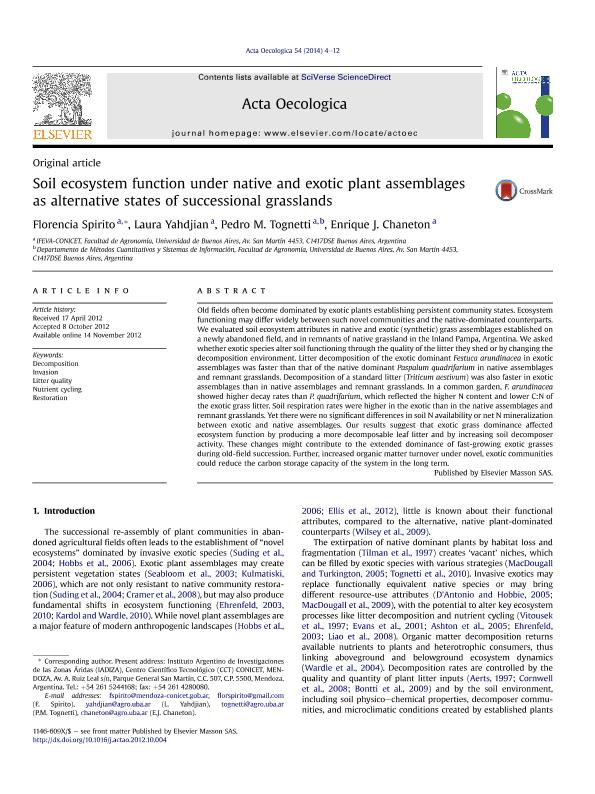Artículo
Soil ecosystem function under native and exotic plant assemblages as alternative states in successional grasslands
Spirito, María Florencia ; Yahdjian, María Laura
; Yahdjian, María Laura ; Tognetti, Pedro Maximiliano
; Tognetti, Pedro Maximiliano ; Chaneton, Enrique Jose
; Chaneton, Enrique Jose
 ; Yahdjian, María Laura
; Yahdjian, María Laura ; Tognetti, Pedro Maximiliano
; Tognetti, Pedro Maximiliano ; Chaneton, Enrique Jose
; Chaneton, Enrique Jose
Fecha de publicación:
14/11/2012
Editorial:
Elsevier
Revista:
Acta Oecologica
ISSN:
1146-609X
Idioma:
Inglés
Tipo de recurso:
Artículo publicado
Clasificación temática:
Resumen
Old fields often become dominated by exotic plants establishing persistent community states. Ecosystem function in such novel plant assemblages may differ widely from that in the alternative, native-dominated counterparts. We evaluated soil ecosystem attributes in native and exotic (synthetic) grass assemblages established on a newly abandoned field, and in remnants of native grassland in the Inland Pampa, Argentina. We asked whether exotics alter soil functioning through the quality of the litter they shed or by changing the decomposition environment. Litter decomposition of the exotic dominant Festuca arundinacea in exotic assemblages was faster than that of the native dominant Paspalum quadrifarium in native assemblages and remnant grasslands. Decomposition of a standard litter (Triticum aestivum) was also faster in exotic assemblages than in native assemblages and remnant grasslands. In a common garden, F. arundinacea showed higher decay rates than P. quadrifarium, which reflected the higher N content and lower C:N of the exotic grass litter. Soil respiration rates were higher in the exotic than in the native assemblages and remnant grasslands. Yet there were no significant differences in soil N availability or net N mineralization between exotic and native assemblages. Our results show that exotic grass dominance affected ecosystem function by creating a more biotically active soil environment as well as by producing a more decomposable leaf litter. These changes might contribute to the extended dominance of fast-growing exotic grasses during old-field succession. Increased organic matter turnover under novel exotic communities would reduce the carbon storage capacity of the system in the long term.
Palabras clave:
Litter Decomposition
,
Biological Invasions
,
Pampas Region
,
Grasslands
Archivos asociados
Licencia
Identificadores
Colecciones
Articulos(IFEVA)
Articulos de INST.D/INV.FISIOLOGICAS Y ECO.VINCULADAS A L/AGRIC
Articulos de INST.D/INV.FISIOLOGICAS Y ECO.VINCULADAS A L/AGRIC
Articulos(OCA PQUE. CENTENARIO)
Articulos de OFICINA DE COORDINACION ADMINISTRATIVA PQUE. CENTENARIO
Articulos de OFICINA DE COORDINACION ADMINISTRATIVA PQUE. CENTENARIO
Citación
Spirito, María Florencia; Yahdjian, María Laura; Tognetti, Pedro Maximiliano; Chaneton, Enrique Jose; Soil ecosystem function under native and exotic plant assemblages as alternative states in successional grasslands; Elsevier; Acta Oecologica; 54; 14-11-2012; 4-12
Compartir
Altmétricas



